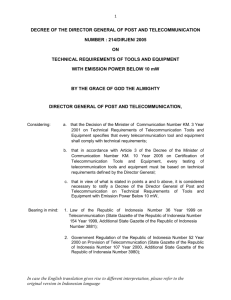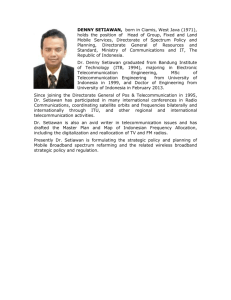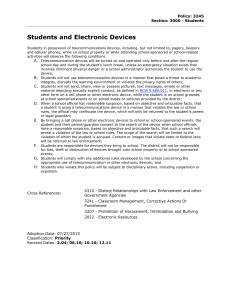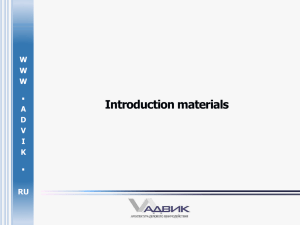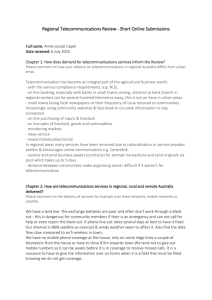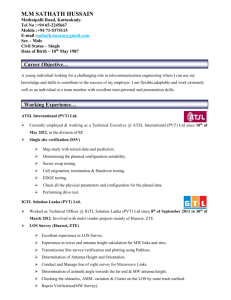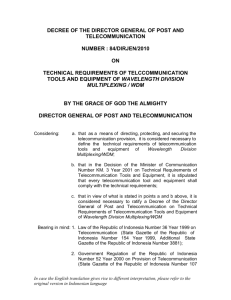decision of the director general of post and telecommunication
advertisement
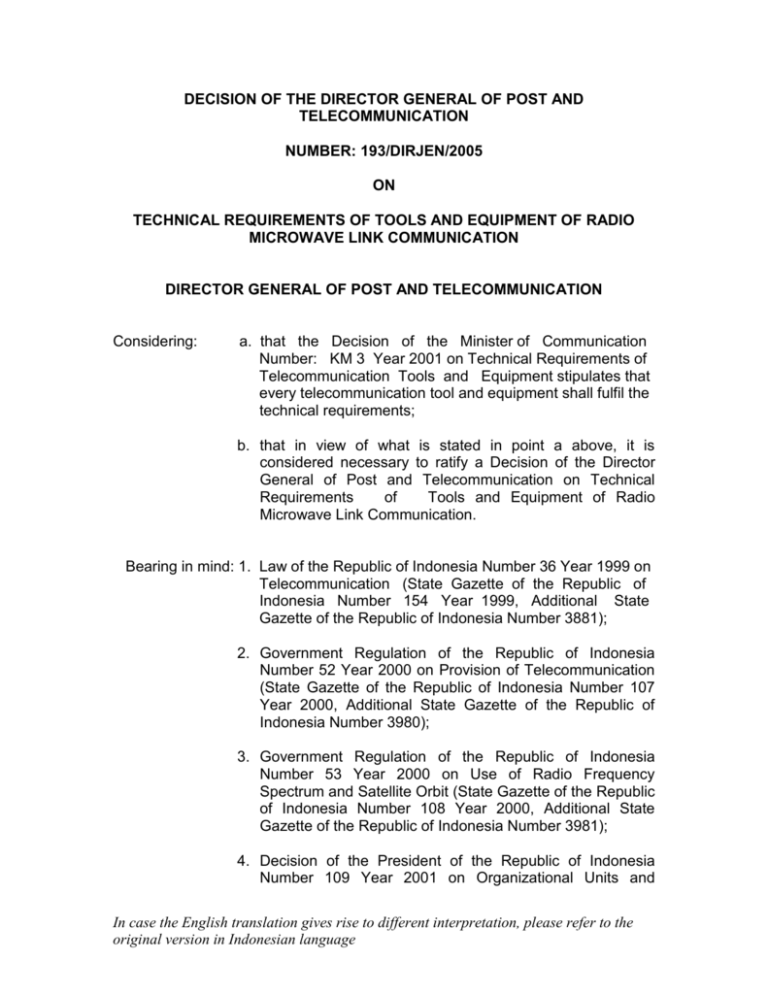
DECISION OF THE DIRECTOR GENERAL OF POST AND TELECOMMUNICATION NUMBER: 193/DIRJEN/2005 ON TECHNICAL REQUIREMENTS OF TOOLS AND EQUIPMENT OF RADIO MICROWAVE LINK COMMUNICATION DIRECTOR GENERAL OF POST AND TELECOMMUNICATION Considering: a. that the Decision of the Minister of Communication Number: KM 3 Year 2001 on Technical Requirements of Telecommunication Tools and Equipment stipulates that every telecommunication tool and equipment shall fulfil the technical requirements; b. that in view of what is stated in point a above, it is considered necessary to ratify a Decision of the Director General of Post and Telecommunication on Technical Requirements of Tools and Equipment of Radio Microwave Link Communication. Bearing in mind: 1. Law of the Republic of Indonesia Number 36 Year 1999 on Telecommunication (State Gazette of the Republic of Indonesia Number 154 Year 1999, Additional State Gazette of the Republic of Indonesia Number 3881); 2. Government Regulation of the Republic of Indonesia Number 52 Year 2000 on Provision of Telecommunication (State Gazette of the Republic of Indonesia Number 107 Year 2000, Additional State Gazette of the Republic of Indonesia Number 3980); 3. Government Regulation of the Republic of Indonesia Number 53 Year 2000 on Use of Radio Frequency Spectrum and Satellite Orbit (State Gazette of the Republic of Indonesia Number 108 Year 2000, Additional State Gazette of the Republic of Indonesia Number 3981); 4. Decision of the President of the Republic of Indonesia Number 109 Year 2001 on Organizational Units and In case the English translation gives rise to different interpretation, please refer to the original version in Indonesian language 2 Functions of Echelon I of State Departments of the Republic of Indonesia; 5. Decision of the Minister of Communication Number KM.10 Year 2004 on Procedure of the Issuance of Certificates of the Type of Telecommunication Tools and Equipment; 6. Decision of the Minister of Communication Number KM.3 Year 2001 on Technical Requirements of Telecommunication Tools and Equipment; 7. Decision of the Minister of Communication Number KM.24 Year 2001 on Organization and Working of the Department of Communication as amended by the Decision of the Minister of Communication Number KM.45 Year 2001. DECIDES To ratify : DECISION OF THE DIRECTOR GENERAL OF POST AND TELECOMMUNICATION ON TECHNICAL REQUIREMENTS OF TOOLS AND EQUIPMENT OF RADIO MICROWAVE LINK COMMUNICATION FIRST : Approve the Technical Requirements of Tools and Equipment of Radio Microwave Link Communication as stipulated in the Attachment of this Decision; SECOND : Put into effect the Technical Requirements of Tools and Equipment of Radio Microwave Link Communication referred to in the FIRST Dictum as a standard and guide in implementing certification or testing of Radio Microwave Link Communication Equipment in the territory of the Republic of Indonesia; . THIRD : This Decision shall come into force as from the date of its ratification. Done at: JAKARTA On : May 23, 2005 __________________ In case the English translation gives rise to different interpretation, please refer to the original version in Indonesian language 3 DIRECTOR GENERAL OF POST AND TELECOMMUNICATION Signed DJAMHARI SIRAT Copies of this Decision are sent to: 1. 2. 3. 4. 5. 6. 7. Minister of Communication; Secretary General of the Department of Communication; Inspector General of the Department of Communication; Head of Research and Development of the Department of Communication; Secretary of the Directorate General of Post and Telecommunication; Directors within the Directorate General of Post and Telecommunication; Heads of Technical Implementation Units/Services of Post and Telecommunication In case the English translation gives rise to different interpretation, please refer to the original version in Indonesian language 4 ATTACHMENT: DECISION OF THE DIRECTOR GENERAL OF POST AND TELECOMMUNICATION NUMBER : 193/DIRJEN/2005 DATE : May 23, 2005 ________________________________________________ TECHNICAL REQUIREMENTS OF TOOLS AND EQUIPMENT OF RADIO MICROWAVE LINK COMMUNICATION CHAPTER I GENERAL PROVISIONS 1. Scope These technical requirements cover: scope, definitions, abbreviations, application, main characteristics, secondary characteristics, tools and equipment of microwave used in terrestrial telecommunication system for Fixed Service, and their testing requirements. 2. Definition What is meant by tools and equipment of radio microwave link communication are tools and equipment that work at frequency above 1 GHz among other things used in telecommunication backbone system and transmission link and have the functions to transmit information from one station/point to another station/point (point to point) or one station/point to many stations/points (point to multipoint). 3. Abbreviations 1. AF 2. AGC 3. BER 4. CISPR 5. DSR 6. EIRP 7. EMC 8. ETSI 9. FCC 10. FDM : Audio Frequency : Automatic Gain Controller : Bit Error Rate : International Special Committee on Radio Interference : Data Signalling Rate : Effective Isotropically Radiated Power : Electro Magnetic Compatibility : European Telecommunication Standards Institute : Federal Communications Commission : Frequency Division Multiplexing In case the English translation gives rise to different interpretation, please refer to the original version in Indonesian language 5 11. FEC 12. FER 13. FSK 14. IF 15. ISDN 16. ITU-R 17. MABR 18. NF 19. PDH 20. QAM 21. QPSK 22. RF 23. RSL 24. SDH 25. SER 26. SRRL 27. STM 28. TCM 29. VSWR 4. : Forward Error Correction : Frame Error Rate : Frequency Shift Keying : Intermediate Frequency : Integrated Service Digital Network : International Telecommunication Union – Radiocommunication : Multiplex Aggregate Bit Rate : Noise Figure : Plesiochronous Digital Hierarchy : Quadrature Amplitude Modulation : Quadrature Phase Shift Keying : Radio Frequency : Receiver Input Signal Level : Synchronous Digital Hierarchy : Symbol Error Rate : Short Range Radio Link : Synchronous Transfer Mode : Trellis Code Modulation : Voltage Standing Wave Ratio Terms For the objective of this standardization, some terms are defined as follows: a. Radio Communication is a communication using radio wave. b. Point to Point is a communication provided by a link from one station to another station. c. Point to Multipoint is a communication provided by a number of links from one station to some stations. d. Backbone Telecommunication is a terrestrial radio communication used for big capacity (SDH STM-1). e. Transmission Link is a terrestrial radio communication used for small and medium capacity. f. Spurious Emission is radio wave emission outside determined bandwidth. g. Main characteristics or main/mandatory characteristics is a general specification or (general) parameter which must be possessed by every tool and equipment of radio microwave link communication. h. Secondary characteristics or voluntary characteristics is a special specification or (special) parameter that may be possessed by every tool and equipment of radio microwave link communication. In case the English translation gives rise to different interpretation, please refer to the original version in Indonesian language 6 CHAPTER II TECHNICAL CHARACTERISTICS 1. Main Characteristics 1.1 Work Frequency . Band (GHz) 1.4 2 4 5 L6 U6 7 8 10 11 12 13 14 15 18 23 27 31 38 55 Frequency Range (GHz) 1.35 – 1.53 1.427 – 2.67 3.6 – 4.2 4.4 – 5.0 5.85 – 6.425 6.425 – 7.11 7.11 – 7.75 7.725 – 8.5 10.3 – 10.68 10.7 – 11.7 11.7 – 12.7 12.7 – 13.25 14.25 – 14.5 14.4 – 15.35 17.7 -21.2 21.2 – 23.6 24.25 – 29.5 31.0 – 31.3 36.0 – 40.5 54.25 – 58.2 Frequency Range refers to ITU – R F series recommendation and/or non-recommendation. Allocation and frequency are defined by Directorate of Frequency Spectrum and Satellite Orbit. 1.2 Transmitter output Power : maximum +32 dBm 1.3 Spurious Emission : a. Spurious emission at interval between B-C is limited to the minimum of 23 dB below peak level where interval B-C is 40% of defined bandwidth. b. Spurious emission at interval between C-D is limited to the minimum of 45 dB below peak level where interval C-D is 40% of defined bandwidth. In case the English translation gives rise to different interpretation, please refer to the original version in Indonesian language 7 Figure 1 : RF Signal Spectrum Explanation - fo : middle frequency. Interval between fo – B is half of the defined breadth of bandwidth Interval between fo – A is 48% of the defined bandwidth Interval between B – C is 40% of the defined bandwidth 1.4 Receiver threshold/sensitivity in the input demodulator : smaller than -65 dBm in BER which is much smaller is equal to 10-3 for digital. 1.5 Modulation : - digital modulation with the selection of FSK, PCM, PSK, TCM, BCM, QAM. - analog modulation with the selection of AM, FM. 1.6 Frequency stability : smaller than ±20 part per million (ppm) or 2 x 10 -5. 1.7 Transmission capacity : refer to standards of PDH ITU-T Rec. G.703, and SDH ITU-T Rec. G.707, G.708, and G.709. 1.8 Service channel : Basic rate: n x9.6 kbps. Broadband (ISDN) rate: n x 64 kbps (Ethernet) Way side channel: 2 Mbps. 1.9 Noise Figure : smaller than 12 dB 1.10 Antenna with the characteristics : VSWR : smaller than 1.5. In case the English translation gives rise to different interpretation, please refer to the original version in Indonesian language 8 Gain: depending on application, the amount may be fixed by operator/vendor in a flexible manner in line with the need. Return loss: greater than 20 dB. Front to back ratio : greater than 30 dB Beamwidth : the width tolerance is maximum 10% from beamwidth design. 1.11 Operating temperature : 0 oC up to and including 55 oC 1.12 Humidity : 0 % - 95 %. Power supply: ±(20 – 60) V DC, with maximum fluctuation of ± 20 %. AC 220V ± 10% , with frequency of 47 – 52 Hz. 2. Secondary Characteristics 2.1 Aggregate bit rate : in line with MUX-DEMUX system used by users. 2.2 Bandwidth IF : maximum width tolerance is 10% from bandwidth filter system. 2.3 EMC and safety : refer to ETSI ETS 300-385 standard and CISPR 22/24. 2.4 Own Alarm system. 2.5 Interface : in line with the kind of application and service to be provided by operator/vendor, by taking into account compatibility with the service or the existing network. 2.6 Redundancy : 1 + 1 hot stand by and N + 1 (frequency diversity and or space diversity). CHAPTER III TESTING REQUIREMENTS 1. Method of Selecting Testing Sample Selection of testing materials is carried out by random sampling according to the prevailing testing procedure. 2. Testing Method The testing method is defined by the testing institution which is capable of showing in a qualitative and quantitative manner that the testing materials comply with the technical requirements. In case the English translation gives rise to different interpretation, please refer to the original version in Indonesian language 9 3. Conditions for Passing the Test The testing result is declared PASS THE TEST, if all the testing materials comply with the provisions contained in the technical requirements. If the testing materials are declared DO NOT PASS THE TEST, all the groups belonging to the testing materials are also declared not passing the test. 4. Conditions of Safety and Health The Tools and Equipment of Radio Microwave Link Communication must be engineered in such a way that users are protected from electrical and electromagnetic disturbances. 5. Conditions of Labelling Every Tool and Equipment of Radio Microwave Link Communication shall be labelled, containing the name of the manufacturer and manufacturing country, brand, type, and serial number and must fulfil the conditions of certification. 6. Method of Packaging The packaging measurement depends on the manufacturer by taking into account the elements of safety, aesthetics, and space efficiency Done at: JAKARTA On : May 23, 2005 __________________ DIRECTOR GENERAL OF POST AND TELECOMMUNICATION Signed DJAMHARI SIRAT In case the English translation gives rise to different interpretation, please refer to the original version in Indonesian language
